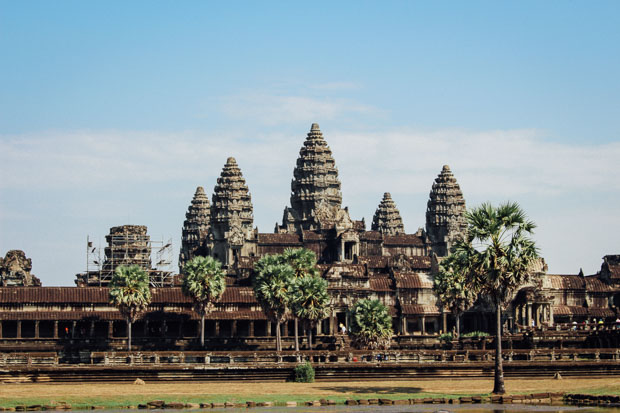
Do’s and Don’ts of Visiting Angkor Wat
How to cover more than 1,000 temples in a 400-square-kilometer area? Good question. Here’s what to do, and what not to do, when visiting Angkor Wat.
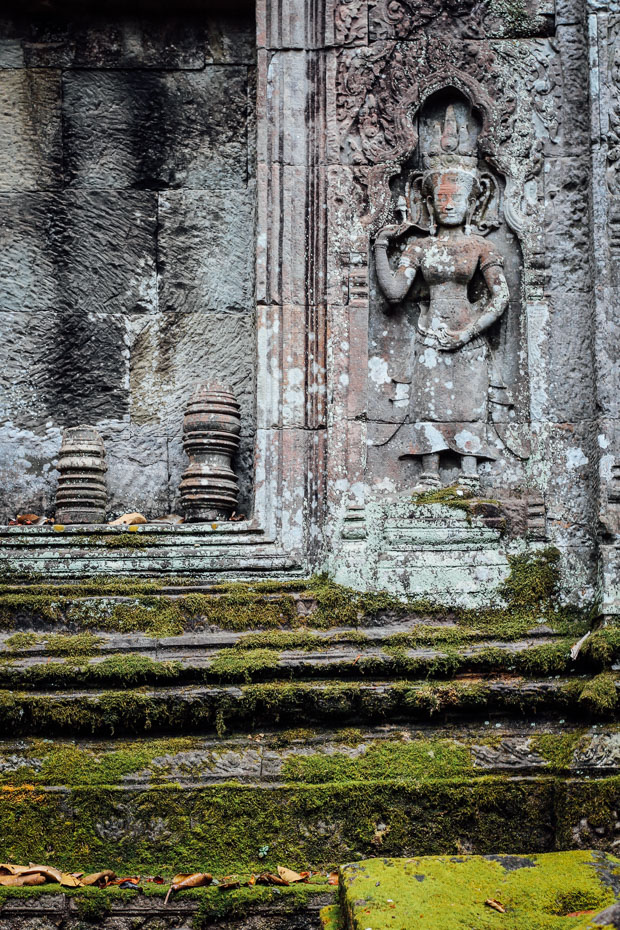
At Ta Prohm
Do
Learn some history – To even try and begin to appreciate the Angkor complex you need to have some background knowledge. When I first visited four years ago, I really knew nothing. I had seen a photo of a friend at Angkor Wat, realized where it was and that I would be traveling through, and planned to spend several days exploring even though I didn’t really know what I was exploring. Before I visited the park, however, I made a trip to the Angkor National Museum which, while a little steep in admission at $12 USD, was incredibly helpful in explaining the region’s history, the importance of the Khmer Empire and what to expect when visiting the temple ruins. The museum is well done and much more contemporary than many Southeast Asian museums with multimedia exhibits and several examples of architecture, bas reliefs and other carvings from the temple sites. It also does a good job in explaining the blend of Hindu and Buddhist beliefs and symbolism found through the temple complex which is crucial in understanding what you’re looking at.
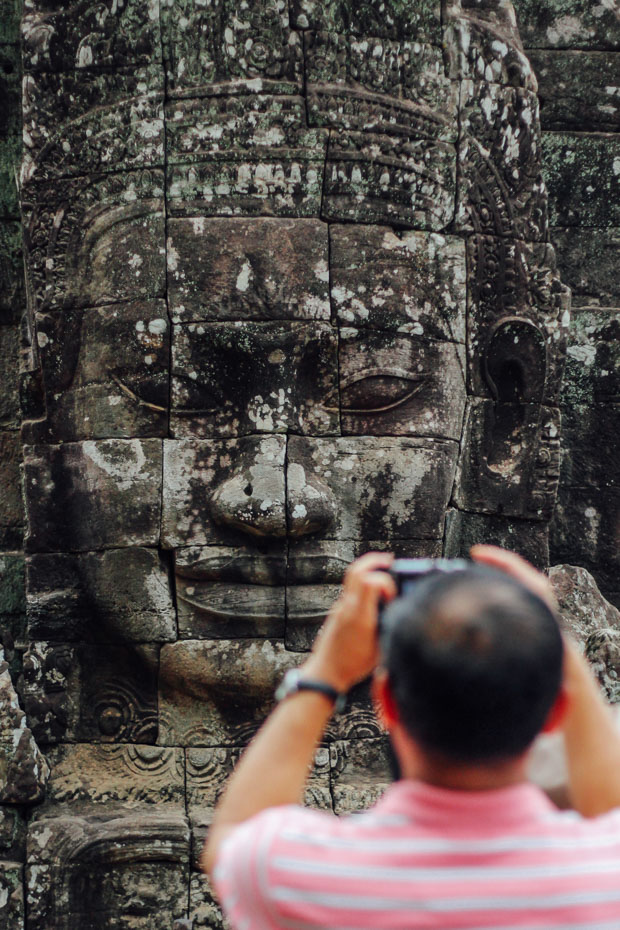
The famous faces of the Bayon
Get up early – It’s hot year round in Siem Reap and you’ll want to start your day early to get some sightseeing in before the heat gets unbearable. (Really, this is true for any traveling in Southeast Asia…mornings here are magical.) Plus, there is so much to see that you need time. The park is open from 5:30 am – 5:30 pm and many people go as soon as it opens to try and catch the sun rising from behind Angkor Wat’s spires. While I haven’t been impressed with the sunrise scene, it is nice to be there as soon as it’s light out. If I were to go again, I think I would go first thing in the morning (starting the day at any temple other than Angkor Wat) then go back into town for a couple hours in the mid-afternoon and return to the park for the last couple hours that it’s open.
Spend several days at the park – The complex is massive – Angkor Archaeological Park covers a 400-square-kilometer area. To say it’s massive is an understatement. It’s not fun rushing through things. When I was first backpacking through Southeast Asia, the entrance fees seemed high, especially compared to most other things in the region, and I debated whether I should try to ‘do it’ in a day to save money…but, really, they’re not bad considering how big the park is, how significant it is, how much upkeep it requires, and that it’s incredible.
You can purchase passes for one, three or seven days.
- 1 Day = $20 USD
- 3 Days = $40 USD and can be used on nonconsecutive days within a week
- 7 Days = $60 USD and can be used on nonconsecutive days within a month
Keep track of your ticket – You need it to get into the main park entrances but there will also be people checking at some of the larger temples while already in the park complex. If you lose it you need to purchase a new pass.
Get a guide – When I first visited Angkor, again as a cheap backpacker, I hired a motorbike driver to take me around for three days as I was traveling alone and wanted the cheapest option to tour the temples (after renting a bicycle and pedaling myself around – which sounds idyllic in theory, but I think would be hell). He had suggestions on where to go but wasn’t a guide and didn’t speak English well. I never really knew what I was doing or looking at, but I got a good ride.
This time I had a driver and a guide thanks to my friends at Where Sidewalks End tours who could fully explain things to me about the differences between temples, their history and significance, details about the Khmer civilization as well as current Cambodian culture, and how everything was connected. Even if you’re on a tight budget, it’s so worth it to get a guide, at least for your first day in the park, to help bring some context to what you’re seeing and experiencing. It’s impossible to know otherwise and adds such a deeper level to your experience and understanding of the Khmer Empire, which is fascinating – at its height it covered Cambodia along with significant parts of modern-day Thailand, Laos and southern Vietnam.
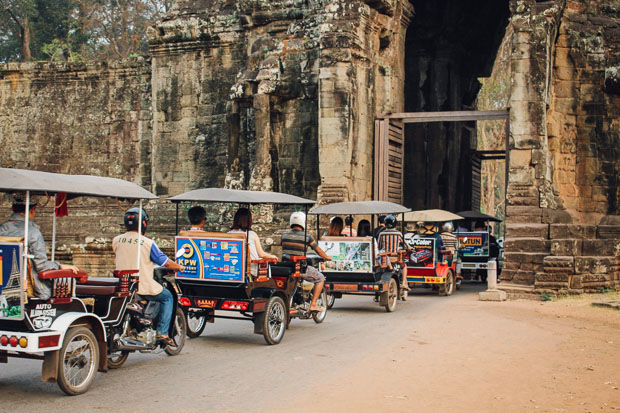
A parade of tuk tuks enter Angkor Thom
Go by tuk-tuk – I’ve now been through the park on the back of a motorbike, in an air conditioned car and in a tuk-tuk, which in Cambodia is kind of like a horse carriage that is attached to the back of a motorbike. I know people who have cycled through the park and raved about it, but it sounds terrible to me. With the heat, sheer size of the park, fact that you have to walk a lot through all the different temples anyway, and distance to and from the archaeological park to Siem Reap (where everyone stays), I simply don’t think I would have the energy, endurance, or enthusiasm to ride a bike.
Have an idea of where you want to go – Even with hiring a guide, do a little research beforehand and have an idea of which temples you don’t want to miss. Of course, you’ll see the ‘must-see’ sites including Angkor Wat (the main one), the Bayon (the one with the faces), Ta Prohm (the one with trees growing over, in and throughout it that was featured in the ‘Tomb Raider’ movie), Preah Khan (the one similar to Ta Prohm, yet for some reason with slight fewer crowds) and Banteay Srei (the one far away from town that is thought to have be done by women because the carvings are so fine and detailed). But sometimes you need to encourage your guide to take you elsewhere. They’re so used to people wanting the same thing that you need to really say you want a different experience and having an idea of what temples you want to visit will help your case. Also, it could work in your favor visiting sites in a different order than the usual ‘circuit’ , i.e. Angkor Wat at sunrise, Bayon, the Terrace of Elephants, Ta Phrom…mix it up to miss the crowds!
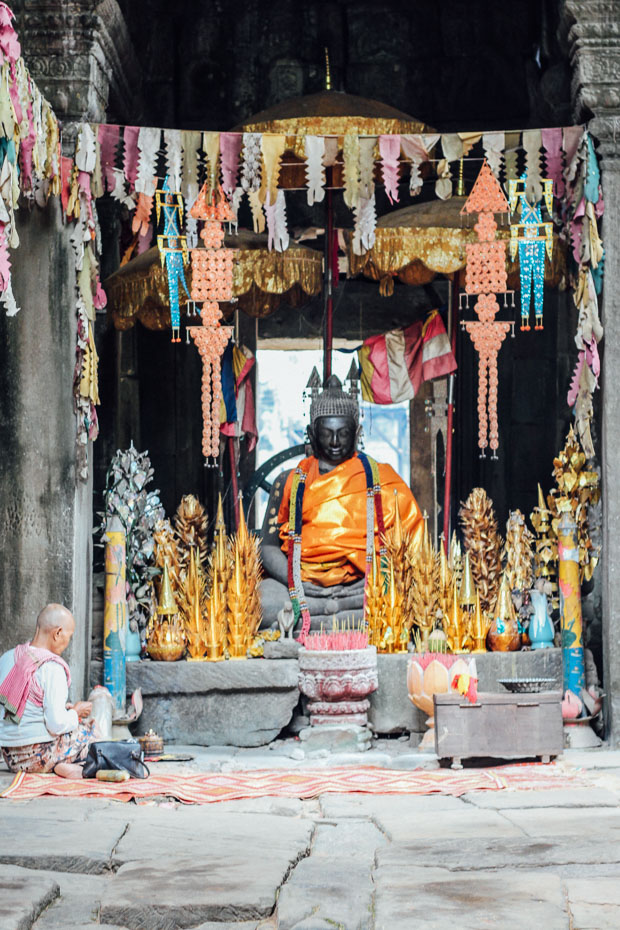
A colorful shrine at Banteay Kdei
Visit smaller temples – Related to the above point, don’t just stop at the main temples. There’s a worn route hitting the most popular sites, and then the second most popular sites. Make an effort to explore the smaller sites that maybe don’t catch your eye at first or that you don’t recognize the name. There are several sites that have almost zero visitors compared to Angkor Wat or Ta Phrom, tell your guide that’s where you want to go and see what gems of knowledge they have to share with you.
Hydrate! – It’s hot. Even if it’s not super hot, you’ll be outside the whole day and walking around. Drink water.
Be prepared for changes in weather – Unless you’re right in the middle of the hot season and can count on high temperatures all day long, prepare for some changes. When I was there last month, not in the rainy season, it was cloudy and started to rain. Of course I didn’t have a jacket, umbrella or even a hat to help keep on trekking.
Take a break if you need to – If you feel yourself getting tired, frustrated with fighting the crowds, hot, or simply losing interest, take a break! Pause your tour to find a good spot to read a book or write in a journal and just enjoying being there. Grab a drink (several temples have stalls nearby selling coconuts, water, soft drinks and even beer) or a snack and just relax for a bit. Especially if you have the 3-day pass, you have time to enjoy the park and don’t need to rush through it.
Get creative with photos – The first time I went to Angkor Wat was in August, so the low season, and I remember being hot and sticky but not overwhelmed by the crowds. This time I went at the beginning of January (high season) and wasn’t completely overwhelmed by the crowds, but was easily annoyed that many places felt like they were just crawling with people. (I know that’s completely hypocritical since I was one of those people but…I got pushed around a lot.) I moved through the main temples quickly because a) I had already seen them b) I was getting shoved and c) I wanted photos for this site and other outlets and quickly got frustrated with all the selfies going on. Also, the weather was gray and overcast.
Get creative. Try different angles, go the opposite direction others are going, mess with editing tools (making photos black and white can save an image that is lackluster in color) and try to be patient. (Check out this post for more travel photo tips.)

Amazing what a little shift of the camera angle and cropping can do…
Don’t
Worry if you miss sunrise – I’ve been twice. It was very early (4:00 – 4:30 am pick up), anticlimactic, frustrating and…meh. I’m sure when the weather is perfect and clear, it’s incredible to see the sun slowly rising over the ancient Angkor Wat. But…in reality I’ve stood in the dark by myself for more than an hour to see more and more people coming and congregating by the reflection pool to the left of the temple and the sky turn from black to light grey. Meh. I would have preferred to sleep two more hours, come to the park around 6:30 am and gone to a different temple to have it all to myself.
Go back to the hotel for breakfast – Apparently a lot of people, including large tour groups, get to Angkor for sunrise then go back to their hotels for breakfast. I don’t get how this make sense.
Underestimate the size of the park – It’s huge. 400 square meters. That’s big. It will easily take you around 15 minutes from your hotel to the park entrance then…it’s huge.
Think all temples look alike – They don’t. They may all be in ruins and of course have similarities (Hey, look – another ancient ruined building built in a Khmer style!) but they still are distinctly different. (And having a guide will help point out and explain those differences so you appreciate them more.)
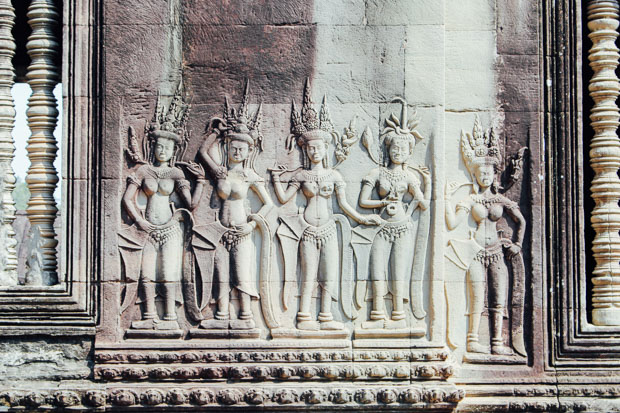
Apsaras…everywhere but still so unique
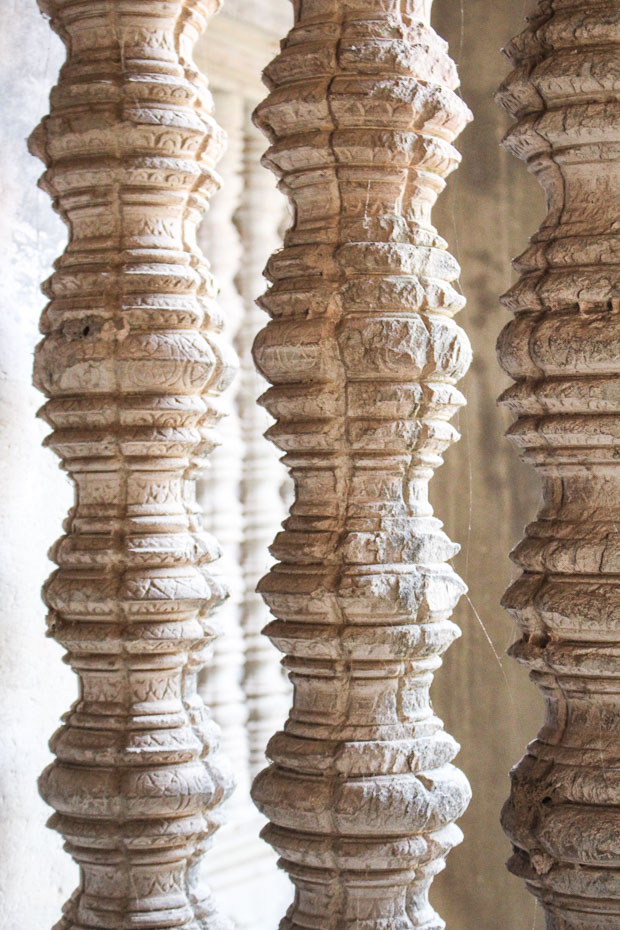
Columns at Angkor Wat
Go where the tour buses are – If you get to a temple and a large tour bus is just starting to let people off, TURN AROUND. Go wander around another nearby site then come back. You don’t want to be walking into a complex with 50 other people.
Forget to cover your shoulders and knees – You’re visiting temples and sacred sites so should have your shoulders and knees covered, especially for women.
Necessarily go three days in a row – If you get a multi-day pass, you don’t have to use it on consecutive days. Take a day off to rest, venture to Tonle Sap, the large freshwater river nearby that’s home to floating villages, or explore the rest of Siem Reap which has a surprising amount of cafes, boutiques, wellness offerings and shopping.
Yell, be rowdy, climb ruins, take naked pics…. – Again, you’re visiting temples and sacred sites, be respectful. (And, apparently it’s a thing to strip down and get a shot naked at Angkor. Not cool.)
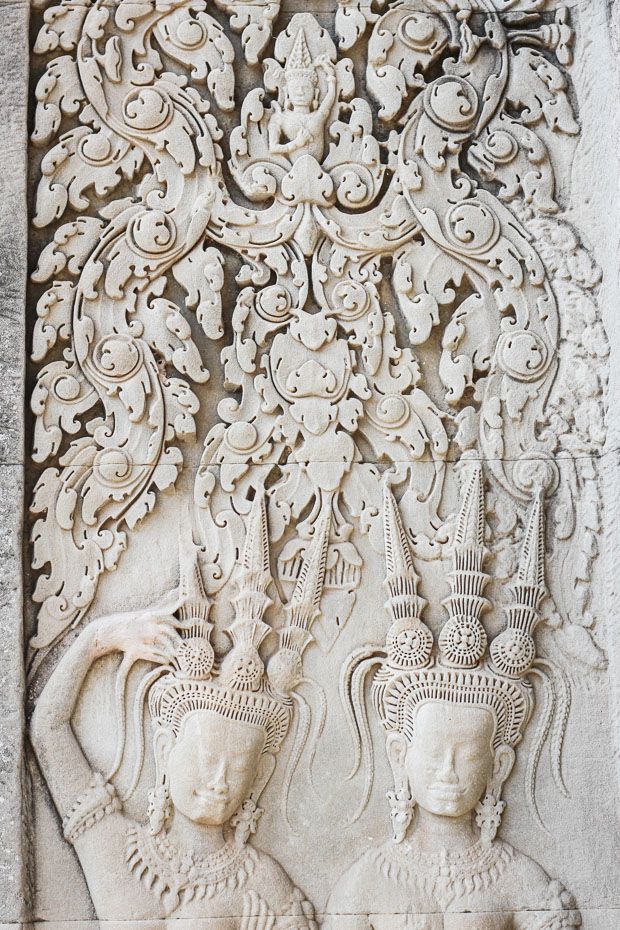
And…more apsaras…
Like this post? Pin it for future travel planning:
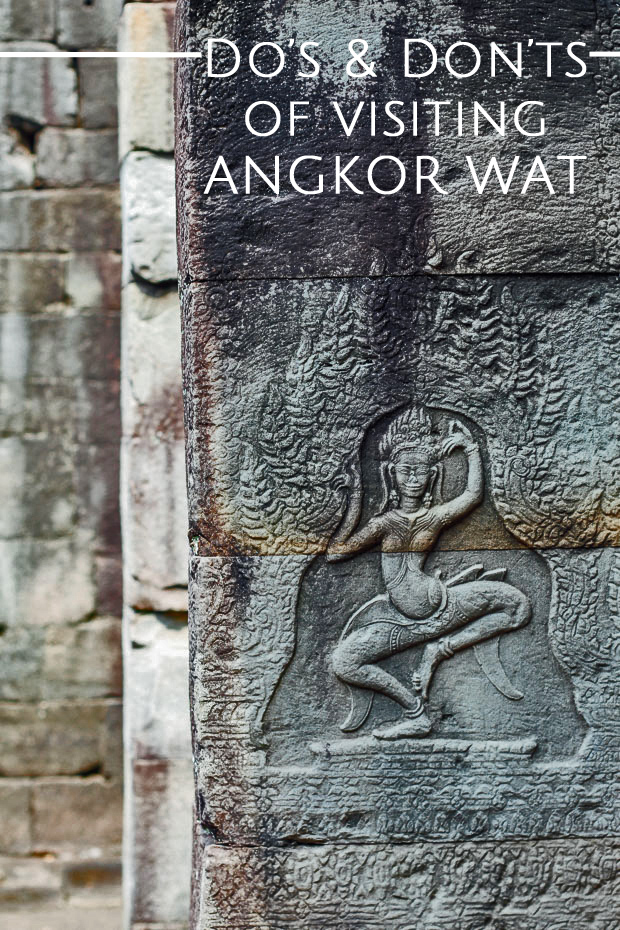
Note: I received a complimentary guide and driver from Where Sidewalks End which operates tours in Southeast Asia with a “TRIP” philosophy: Travel Responsibly, Impact Positively with an emphasis on sustainable, ethical travel. While I just went for one day with their guide, usually they offer a 4-day tour combining both Angkor Wat and Siem Reap including accommodation. Learn more about their Angkor Wat tour here.
Hey! I'm Alana and I've spent nearly the past decade living in Chiang Mai, Thailand, working as a writer and photographer. I started Paper Planes as a place to share local insight, special places, and how to travel well through a range of experiences — from hostels to high-end hotels, street meat to multi-course meals.
New places are always calling my name...
2/11/16
Leave a Reply
let me join you in your inbox
Enter your email for a taste of different worlds, must-read posts, and special offers.
(Don't worry, I'll never spam you — just send the good stuff.)
Visited Angkor Wat 5 years ago and loved it. i did bike but was very fit, my friend was less fit and she nearly gave up after few hours:) I want to go back after reading above to get another perspective on it. Beautiful interesting place.
Ahhh, it just sounds so hot to bike!
Great tips – especially the one about reading about Angkor Wat prior to visiting. It’s amazing how much more enjoyable travel can be when you now about the history of the landmarks. It’s also wonderful you had a great guide.
I am planning on going next summer. I cant believe people would be so disrespectful to take pictures naked at these temples. Would you go naked in a church or a syngague or a mosque?
It’s not 400 square metres!!!
Ha! kilo…
Great read. Thanks for sharing. Here now in Siem Reap and I’m glad I’ve read this before my trip to the temples tomorrow.
Great advice, thank you
Hi Alana,
Thanks for your great article! We are a local startup in Siem Reap, called BookAngkorTukTuk.com, and we offer something unique, being able to book curated tuk tuk tours online. With secured payment, but also helping local people, villages and children. You can have a look on our website! Happy to have you onboard one of our tours next time you will be around.
Cheers
Ben